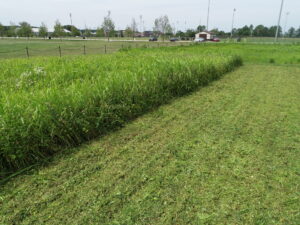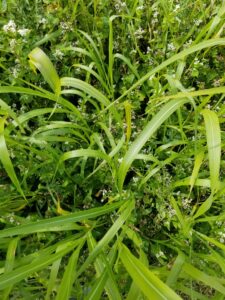What can a relative of broom corn do for you on a vegetable farm? Build biomass while beating the heat! Sorghum-sudangrass (Sorghum x drummondii) (Figure 1) is a summer-loving hybrid cover crop species. Its parents are wild sorghum, native to sub-Saharan Africa, and domesticated sorghum, known as broom corn or milo in our part of the world. Sorghum-sudangrass is sometimes referred to as sudex. Because of its parentage, sorghum-sudangrass is well-adapted to warm weather and can withstand drought.
Sorghum has been grown around the world for food for thousands of years. Peoples of Asia, India, and Africa cultivated sorghum for fermentation, distillation, flours, and syrups. We continue to use sorghum as a food grain today. It can be particularly useful for people whose diets must restrict or eliminate gluten from wheat. Sorghum also has utility as a tool – after the grain is stripped from its panicles, stems can be lashed to a handle to make a broom.
Sorghum-sudangrass (SSDG) is a close cousin of corn (Zea mays). Both species share many characteristics. Not only do they look similar, but they are adapted to similar growing conditions. Both require warm weather, can withstand drought, and have a similar growing season in Indiana. Unlike corn, SSDG can be cut for hay more than once per season. SSDG has a tendency to tiller and regrows at a rapid rate, making it a good choice for livestock producers who want to cut hay or graze quality forage during the summer months. On the flip side, SSDG produces a compound called dhurrin, which will lead to prussic acid formation and livestock poisoning if animals graze the plant after a frost. More information about prussic acid poisoning in the sorghum family can be found here: https://www.agry.purdue.edu/ext/forages/publications/ay263.htm
Sorghum-sudangrass is a tall cover crop, soaring to a height of up to 10 feet at maturity. SSDG prefers mildly acidic soil (pH 6.0-6.5) and good fertility but will tolerate many conditions other than flooding and ponding. It generally reaches maturity between 80-100 days after planting. On the vegetable farm, SSDG provides several benefits:
- Weed suppression
- Straw mulch (after termination)
- Nutrient scavenging
- Lots of biomass production (which increases soil organic matter)
Drilling and broadcasting are both appropriate seeding methods for SSDG. Plan to seed when soil temperatures are in the 60s, usually by late May or early June. Use a 40 lb/acre rate when drilling and adjust upward toward 50 lb/acre when broadcasting. Broadcasting works best when there is a little extra soil moisture available.
On a vegetable farm, SSDG makes for a good straw mulch material for vining crops. Growing for mulch might require you to green fallow the vining crop bed with SSDG the year before you plan to plant pumpkins, squash, or watermelon. SSDG is also a good candidate to suppress root knot nematodes that can affect vegetable crops. However, SSDG should not precede alliums in the crop rotation – the incidence of onion thrips could increase with any grass crop that comes before onions, leeks, garlic, etc., in the crop rotation. See Crop Rotation on Organic Farms for more information on sequencing SSDG with other crops.
Challenges with termination are the biggest drawback to using SSDG on the vegetable farm. Mowing, particularly with a flail mower or sickle bar mower, is an effective means of terminating the crop and simultaneously mulching the residue. However, incorporation or tarping might be required if the crop continues to grow and tiller after a mowing pass. Unlike cereal rye, sorghum-sudangrass is not easily terminated with basic lawn and garden tools like weedeaters and rotary mowers. Heavier tools, like PTO-equipped two-wheel and four-wheel tractors, make for less hassle and more efficient management. SSDG does not respond to roller crimping as well as small grain cover crops species like cereal rye and triticale. After termination, more aggressive fertilizer application and sidedressing will be needed to make up for the nutrient tie-up that occurs with thick, carbon-heavy residue. This residue is best suited to transplanting a succeeding crop rather than direct-seeding, so careful crop rotation planning is needed to make sure that you don’t accidentally limit your planting options by using SSDG as a cover crop.

Figure 2. Sorghum-sudangrass and buckwheat residue after a pass with a Berta flail mower. Approximately 6 weeks after planting. Standing SSDG and buckwheat remain on the left (Photo by Ashley Adair).
In July 2020, Purdue Student Farm Manager, Chris Adair, managed one crop rotation block on the farm for a summer cover crop management demonstration. A mixture of SSDG and buckwheat were planted to achieve a thick stand for weed suppression in preparation for a fall crop planting. Part of the demonstration was to show how much residue SSDG and buckwheat produce when terminated with a flail mower. Chris used a BCS-mounted Berta flail mower (Figure 3), walking at a slow pace to terminate.
This article is the first in a new series of articles for the Vegetable Crops Hotline called “Cover Crop Species Spotlight.” Make sure to look for more species spotlights in past (Issue 718) and future editions of the VCH!

